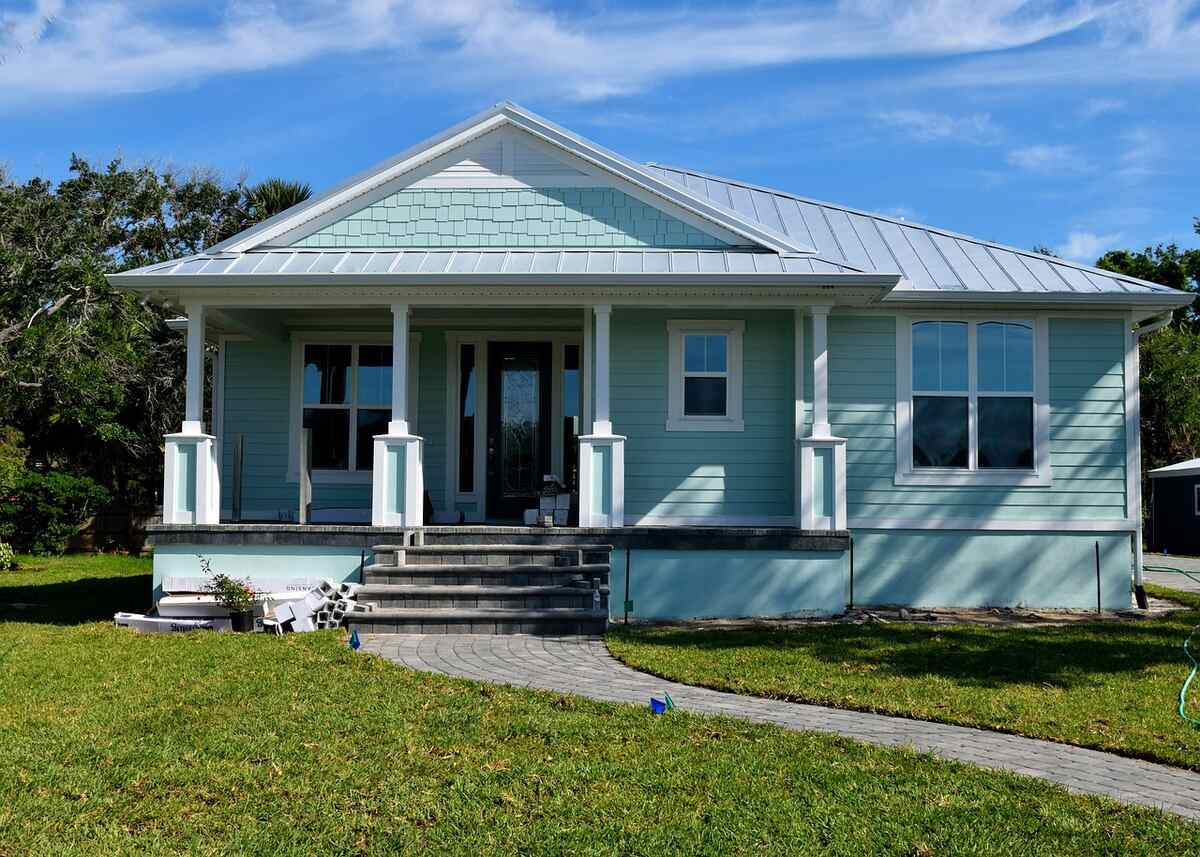
Most homeowners know to plan lawn fertilization from April to September when Florida’s warm-season grasses are actively growing. But there is more to getting the lawn fertilization schedule in Florida right.
We cover all the essential details in this article. Read about fertilizer bans, the unique Florida soil, the best fertilizer for the Sunshine State, and how to calculate and spread it correctly – plus other pro tips to keep in mind for a green, healthy lawn all year round in Florida.
- 1. The Correct Lawn Fertilization Schedule in Florida
- 2. Lawn Care in Counties with Fertilizer Ordinances
- 3. Floridians Should Test the Soil
- 4. The Best Fertilizer for Florida Lawns
- 5. How Much Nitrogen Does Your Grass Need?
- 6. Calculate the Fertilizer Amount in Three Steps
- 7. Prepare Your Florida Lawn for Fertilization
- 8. How to Apply Fertilizer Like a Pro in the Sunshine State
- 9. How to Green a Florida Lawn in the Summer
- 10. Reducing Fertilizer Needs
- 11. Choose the Right Lawn Care Service
- FAQ About Lawn Fertilization in Florida
1. The Correct Lawn Fertilization Schedule in Florida
The best time to apply fertilizer is during the growing season. This is when the grass needs and can absorb the nutrients most efficiently. During winter months, warm-season grasses go dormant in North and Central Florida and slow their growth in South Florida. Fertilizing during the winter compromises weed control, feeding winter weeds such as crabgrass instead of your grass. Learn more about proper winter lawn care with our winter lawn care tips for Florida.
Here are the best months to fertilize in Florida depending on your location:
| Region of Florida | First Fertilizer Application | Last Fertilizer Application |
| North Florida and the Panhandle region | Mid-April | Mid to late September |
| Central Florida | Early April | Early October |
| South Florida | All year round (better in early spring) | All year round (better until the end of November) |
To avoid forced growing, wait two weeks after the grass greens up in the spring to apply the first round of fertilizer for the year.
Pro tips on your Florida fertilization schedule:
- Wait 30-60 days after planting a new lawn before applying fertilizer. It gives the plants time to focus on root growth.
- Don’t fertilize when heavy rain is forecasted within 24 hours or while your area is under flood, storm, or hurricane warning. Heavy rainfall washes away the fertilizer into storm drains.
2. Lawn Care in Counties with Fertilizer Ordinances
Many counties and cities across Florida ban the use of nitrogen and phosphorus fertilizers from June to September. These bans protect the local watershed from fertilizer leach during the wet season.
Use the Florida Fertilizer Ordinances app to check for fertilizer bans in your city and county. It was developed as part of the Florida-Friendly Landscape program by the University of Florida. Check out our article on Florida-Friendly Landscaping for more information.
How to fertilize with a ban during summer
Apply a slow-release product in late spring (end of May). It spreads low doses of nitrogen for 3 to 4 months.
Fertilize again when the restricted period is over.
Nutrients you can apply during summer even with bans
You can use nitrogen and phosphorus-free summer fertilizer blends. They contain iron, manganese, potassium, lime, and other allowed nutrients.
Compost is also an option you can use year-round. It’s natural, eco-friendly, and excellent for soil health. Always test the soil before applying fertilizer or amendments to make sure these nutrients are needed.
3. Floridians Should Test the Soil
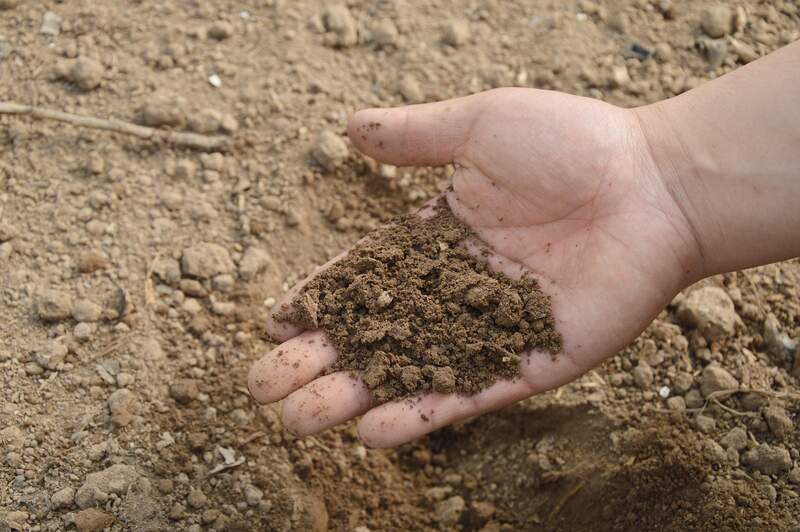
Testing the soil before you fertilize the lawn is the best way to apply fertilizer effectively and avoid excess.
Sampling the soil is easy and takes a few minutes. As for the soil test itself, you have two options:
- Buy a DIY kit online or in a local garden store. They return data in seconds.
- Go for a more precise method. Take or send the soil sample to your local UF/IFAS Extension Office. You’ll receive a report with detailed recommendations on fertilizing your home lawn.
4. The Best Fertilizer for Florida Lawns
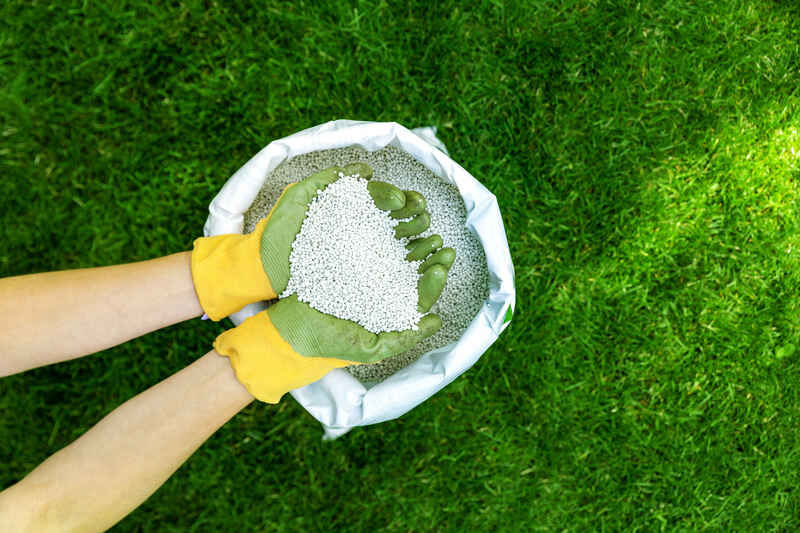
A fertilizer with slow-release nitrogen is the best choice for Florida lawns. It allows the grass to absorb the nutrients at its own pace, preventing:
- Root burn
- Excessive growth
- Run-off and leaching
It’s also required by law. The amount of slow-release nitrogen requested by local regulations varies by county:
- If you’re doing lawn care in Orlando or Miami, look for fertilizer with at least 65% slow-release nitrogen in the total amount of nitrogen.
- For lawn maintenance in Tampa Bay or Jacksonville, homeowners can use a 50% slow-release nitrogen product.
Soil is different in Florida compared to other states. It has enough phosphorus for plants to thrive but is deficient in potassium (and potassium is crucial for lawns). That is why you need fertilizers:
- With little to no phosphorus.
- Containing an amount of potassium that is at least half of the nitrogen.
But there are exceptions. Some soils can become deficient in phosphorus. Signs of phosphorus deficiency include:
- Grass slows growth
- Leaf blades turn dark green
- New-grown leaves come out with a purple tint
If you suspect a deficiency, take a soil test to check phosphorus levels before treating it.
Pro tips on how to choose a fertilizer for Florida lawns:
- Always buy fertilizers for turf use. Don’t replace them with products meant for flowers or veggies.
- Avoid country-wide formulas. They typically have too much phosphorus and not enough potassium. Look for Florida-friendly products.
- Avoid weed and feed products. They are rarely effective. Nitrogen fertilizer should be applied at least one month after pre-emergent herbicides for the best results.
5. How Much Nitrogen Does Your Grass Need?
Although fertilizer has many other nutrients, nitrogen is the one we are always using to calculate quantities. Each type of grass in Florida has different nitrogen needs depending on its growth rate:
- Centipedegrass is the most low-maintenance warm-season grass, requiring only up to 3 pounds of nitrogen per year per 1000 sq. ft. of lawn.
- Bermudagrass is the most hungry grass, requiring up to 6 lbs. of nitrogen per year per 1000 sq. ft. of lawn (less if the Bermuda grows in partial shade).
Here are the annual nitrogen amounts per 1000 sq. ft. of lawn recommended by the University of Florida for the most common Florida turfgrasses.
| Type of Grass | Amount of Nitrogen Recommended for North Florida | Amount of Nitrogen Recommended for Central Florida | Amount of Nitrogen Recommended for South Florida |
| Bahiagrass | 1 – 3 lbs / 1000 sq. ft. | 1 – 3 lbs / 1000 sq. ft. | 1 – 4 lbs / 1000 sq. ft. |
| Centipedegrass | 0.4 – 2 lbs / 1000 sq. ft. | 0.4 – 3 lbs / 1000 sq. ft. | 0.4 – 3 lbs / 1000 sq. ft. |
| St. Augustinegrass | 2 – 4 lbs / 1000 sq. ft. | 2 – 5 lbs / 1000 sq. ft. | 4 – 6 lbs / 1000 sq. ft. |
| Zoysiagrass | 2 – 3 lbs / 1000 sq. ft. | 2 – 4 lbs / 1000 sq. ft. | 2.5 – 4.5 lbs / 1000 sq. ft. |
| Bermudagrass | 3 – 5 lbs / 1000 sq. ft. | 4 – 6 lbs / 1000 sq. ft. | 5 – 7 lbs / 1000 sq. ft. |
Excess nitrogen makes the grass vulnerable to fungal diseases such as the brown patch, Pythium blight, and leaf spot. It also compromises the plant’s resistance to common Florida pests like chinch bugs or mole crickets.
According to Florida Regulation (5E-1.003), you’re limited to applying a maximum of 1 pound of nitrogen per 1000 square feet per application. Split the annual amounts recommended for your type of grass into 2, 3, or more applications to follow this rule.
For example, if you decide to apply 3 lbs. per year per 1000 sq. ft. of Zoysiagrass in three sessions, you can spread:
- 1 lb. of nitrogen in April
- 1 lb. of nitrogen in June or July
- 1 lb. of nitrogen in September or October
6. Calculate the Fertilizer Amount in Three Steps
Now you know how much nitrogen you want to apply in one application for your type of grass. The next step is to figure out how many pounds of mixed fertilizer you will put in the spreader.
To calculate the precise amount, follow these steps:
- Measure the area you need to fertilize (the surface of the lawn, without walkways or flower beds).
- Calculate how much nitrogen you need for the entire area. For example, if you apply 1 lb. per 1000 sq. ft., for a 2500 sq. ft. lawn, you’ll need 2.5 lb. of nitrogen.
- Read the product label to determine how much fertilizer you need to spread. For example, a 14 lbs. bag of an 8-2-10 fertilizer (8% nitrogen, 2% phosphorus, 10% potash) has 1.12 lbs. of nitrogen. You’ll need to spread 31.25 lbs. of fertilizer (more than 2 bags) to ensure 2.5 lbs. of nitrogen.
You can use this fertilizer calculator if you live in Orange County or another county that requests 65% slow-release nitrogen fertilizers.
Pro tips on calculating the amount of fertilizer:
- Divide your lawn into sections (back, front, side yard) to simplify measurements.
- Use an app to measure the lawn size faster. Some popular options are LawnChick’s Lawn Size Calculator, Measure My Lawn, Google Maps, Planimeter, Global Syn-Turf, and My Lawn Size Calculator.
7. Prepare Your Florida Lawn for Fertilization
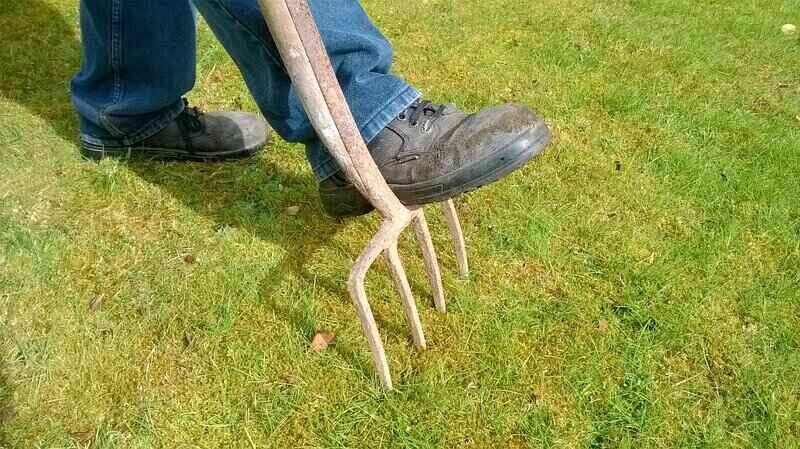
To get the nutrient uptake as close to 100% as possible, ensure the soil can adequately absorb the fertilizer. You do this by:
- Clearing the lawn of leaves, twigs, and other debris covering the lawn (especially if you have large shade trees in your yard or nearby).
- Reducing compaction through soil aeration. Soil is compacted by foot traffic but also by heavy rain in Florida. Rain creates a crust that is ½ inches deep and lowers nutrient absorption.
- Removing thatch that is thicker than ¼ inch. Bermudagrass and St. Augustine are prone to thatch. Centipedegrass can also promote it if overfertilized.
8. How to Apply Fertilizer Like a Pro in the Sunshine State
To avoid root burn and ensure healthy growth, you must spread the fertilizer uniformly across the lawn. The easiest way is with a broadcast spreader. Here are the main steps to follow when fertilizing:
- Read the instructions on the fertilizer label and set the spreader accordingly.
- Split the fertilizer amount in two.
- Add one half into the hopper.
- Run the spreader back and forth across the width of the lawn.
- Turn the spreader off.
- Add the other half of the fertilizer.
- Turn the spreader on.
- Switch directions and spread on the length of the lawn, perpendicular to the first application.
- Turn the spreader off.
- Clean the spreader on the grass to avoid getting fertilizer on the sidewalk or pavement.
- Apply 1/4 inch of water to clean the granular slow-release fertilizer from the grass blades and help it soak into the soil.
Pro tips about fertilizing the lawn:
- Use a deflector shield to keep fertilizer on the lawn and away from sideways and driveways.
- Create a 15-foot no-fertilizer, no-pesticide buffer area between the lawn and a waterfront. Use plants native to Florida that thrive without extra feeding and can collect excess nutrients from the grass area to fill this buffer.
- If you spill fertilizer on your lawn or driveway, sweep it up, don’t rinse it.
9. How to Green a Florida Lawn in the Summer
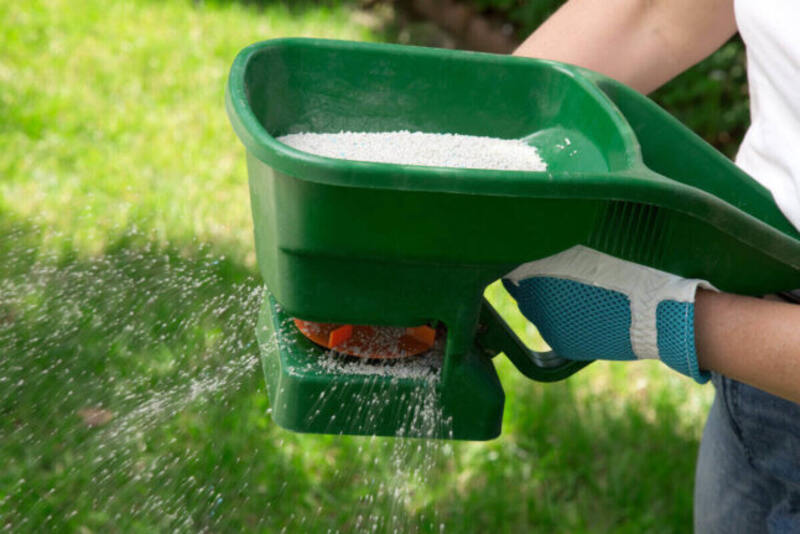
It’s the middle of the summer in the Sunshine State, and your St. Augustine or Bahia lawn turns a light green color. Most homeowners are tempted to fix this with a nitrogen spread, but there’s a better choice.
You can get the deep dark green back by applying some iron without the excessive grass growth and the risk of run-off. A yellowing lawn can also be a sign of iron (or manganese) deficiency. For more information, check out “Why Add Iron Fertilizer to Your Lawn?“
10. Reducing Fertilizer Needs
Your home lawn needs less fertilizer if it’s healthy and correctly mowed and watered:
- Mowing is an essential factor. If you cut the grass too short, too often, it intensifies its growth rate to keep up and needs more nutrients and water to do so.
- Irrigation is also important. Too much water stimulates a shallow root system and excessive growth. Both factors also lead to higher fertilizer needs. Turn on the irrigation system only when the grass shows signs of drought and apply ½ to ¾ inches of water per irrigation event. See our lawn watering tips for Florida for more advice on properly irrigating your lawn.
An excellent way to reduce the need for synthetic fertilizers is to leave the grass clippings on the lawn. The average home generates about 400 pounds of grass clippings per year, providing a significant amount of slow-release nitrogen.
11. Choose the Right Lawn Care Service
What happens on your property is your responsibility. Make sure the lawn care professionals you’re working with go by the book and follow the local fertilizing ordinances. They also need to be trained and licensed for fertilizer application. Going local is best since regulations vary from county to county and city to city.
FAQ About Lawn Fertilization in Florida
Choose a “Turf” formula meant for the Florida climate, soil conditions, and fertilizer ordinances, with:
• 30% to 65% slow-release nitrogen.
• At least half as much potassium as nitrogen.
• Little to no phosphorus.
Yes, but not at the same time all across the state. It is best to make the last application in North Florida in September since grasses go dormant earlier. Central Florida lawn care can include fertilizer application until early October. In the south, you can fertilize until late November.
Nitrogen and phosphorus fertilizer are banned in some Florida counties and cities during the wet season, from June to September.
Generally, no. Most Florida soils are rich enough in phosphorus.
Locals know how to keep the grass green during summer months without nitrogen. They do the following:
• Use iron.
• Test and treat for other deficits (manganese, magnesium).
• Balance an acidic pH with lime.
Give Your Florida Lawn the Best Fertilization Year Round!
Soil, weather, and rules make Florida unique when fertilizing turfgrasses. There are a lot of details to keep in mind. It is often easier to hire a professional for the entire fertilizing schedule.
Find a lawn care company near you and get a free quote through LawnStarter, whether you live in Jacksonville, Miami, Tampa, Orlando, St. Petersburg, or anywhere in the Sunshine State.
Main Image Credit: Pixabay